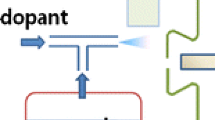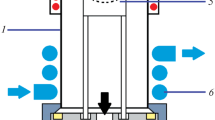Abstract
A trend is observed in mass spectrometry, in which solid samples without prior dissolution and chromatographic separation are brought directly into the ion source and are ionized, e.g., by corona discharge (Atmospheric Solids Analysis Probe) or plasma (Direct Analysis in Real Time). The Direct Inlet Probe-atmospheric-pressure chemical ionization (APCI) ion source presented here, which was coupled to a high-resolution quadrupole time-of-flight–mass spectrometer, differs from most of the other ion sources in having temperature-programmed heating of the sample. The resulting possibility to reduce ion suppression and ion-molecule reactions in the ion source was shown by the separation of two fatty acid methyl esters as a result of their boiling point difference. Using caffeine as sample, certain source parameters such as the auxiliary gas flow, the drying gas flow, and the position of the probe tip in the ion source were optimized. The ability to perform quantitative analyses was shown by the linear concentration response (R 2 = 0.9984) observed when analyzing different caffeine concentrations. An extract of a Chinese medicinal herb was used to examine the reproducibility (relative standard deviations of the most abundant m/z signals were ≤8.1 %). It was also possible to distinguish milled samples of Radix Angelicae sinensis and Radix Angelicae gigas from each other and to identify the coumarins they contain without sample preparation. Supplying synthetic air instead of nitrogen to the ion source makes APCI in the negative mode possible as well; this was proven by the analysis of n-nonyl-β-d-maltoside.






Similar content being viewed by others
References
Matuszewski BK, Constanzer ML, Chavez-Eng CM (2003) Anal Chem 75:3019–3030
Annesley TM (2003) Clin Chem 49:1041–1044
McEwen CN, Mckay RG, Larsen BS (2005) Anal Chem 77:7826–7831
McEwen C, Gutteridge S (2007) J Am Soc Mass Spec 18:1274–1278
Ray AD, Hammond J, Major H (2010) Eur J Mass Spectrom 16:169–174
Cody RB, Laramee JA, Durst HD (2005) Anal Chem 77:2297–2302
Takats Z, Wiseman JM, Gologan B, Cooks RG (2004) Science 306:471–473
Laramee JA, Cody RB (2007) In: Gross ML, Caprioli RM (eds) The encyclopedia of mass spectrometry, volume 6. Elsevier, Amsterdam
Schurek J, Vaclavik L, Hooijerink H, Lacina O, Poustka J, Sharman M, Caldow M, Nielen MWF, Hajslova J (2008) Anal Chem 80:9567–9575
Nilles JM, Connell TR, Durst HD (2009) Anal Chem 81:6744–6749
Lloyd JA, Harron AF, Mcewen CN (2009) Anal Chem 81:9158–9162
Ahmed A, Cho YJ, No MH, Koh J, Tomczyk N, Giles K, Yoo JS, Kim S (2011) Anal Chem 83:77–83
Pan HF, Lundin G (2011) Eur J Mass Spectrom 17:217–225
Maleknia SD, Vail TM, Cody RB, Sparkman DO, Bell TL, Adams MA (2009) Rapid Commun Mass Sp 23:2241–2246
Edison SE, Lin LA, Gamble BM, Wong J, Zhang K (2011) Rapid Commun Mass Sp 25:127–139
Yu SX, Crawford E, Tice J, Musselman B, Wu JT (2009) Anal Chem 81:193–202
Van Berkel GJ, Pasilis SP, Ovchinnikova O (2008) J Mass Spectrom 43:1161–1180
McEwen CN, Larsen BS (2009) J Am Soc Mass Spec 20:1518–1521
Lao SC, Li SP, Kan KKW, Li P, Wan JB, Wang YT, Dong TTX, Tsim KWK (2004) Anal Chim Acta 526:131–137
Constapel M, Schellentrager M, Schmitz OJ, Gab S, Brockmann KJ, Giese R, Benter T (2005) Rapid Commun Mass Sp 19:326–336
Acknowledgment
The authors thank Scientific Instruments Manufacturer GmbH (SIM) for providing the direct inlet probe and Shimadzu Europa GmbH for the GC × GC-MS. Sonja Krieger also thanks the Zentrum fuer Graduiertenstudien for funding.
Author information
Authors and Affiliations
Corresponding author
Rights and permissions
About this article
Cite this article
Krieger, S., von Trotha, A., Leung, K.SY. et al. Development, optimization, and use of an APCI source with temperature-controlled vaporization of solid and liquid samples. Anal Bioanal Chem 405, 1373–1381 (2013). https://doi.org/10.1007/s00216-012-6531-4
Received:
Revised:
Accepted:
Published:
Issue Date:
DOI: https://doi.org/10.1007/s00216-012-6531-4




